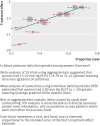Prognosis research strategy (PROGRESS) 4: stratified medicine research
- PMID: 23386361
- PMCID: PMC3565686
- DOI: 10.1136/bmj.e5793
Prognosis research strategy (PROGRESS) 4: stratified medicine research
Abstract
In patients with a particular disease or health condition, stratified medicine seeks to identify those who will have the most clinical benefit or least harm from a specific treatment. In this article, the fourth in the PROGRESS series, the authors discuss why prognosis research should form a cornerstone of stratified medicine, especially in regard to the identification of factors that predict individual treatment response
Conflict of interest statement
Competing interests: All authors have completed the ICMJE uniform disclosure form at
Figures




References
-
- Hudis CA. Trastuzumab—mechanism of action and use in clinical practice. N Engl J Med 2007;357:39-51. - PubMed
-
- Riley RD, Hayden JA, Steyerberg EW, Moons KGM, Abrams K, Kyzas PA, et al. Prognosis research strategy (PROGRESS) 2: Prognostic factor research. PLoS Med 2013, 10.1371.journal/pmed.1001380. - DOI - PMC - PubMed
-
- Wolff AC, Hammond ME, Schwartz JN, Hagerty KL, Allred DC, Cote RJ, et al. American Society of Clinical Oncology/College of American Pathologists guideline recommendations for human epidermal growth factor receptor 2 testing in breast cancer. J Clin Oncol 2007;25:118-45. - PubMed
-
- Slamon DJ, Clark GM, Wong SG, Levin WJ, Ullrich A, McGuire WL. Human breast cancer: correlation of relapse and survival with amplification of the HER-2/neu oncogene. Science 1987;235:177-82. - PubMed
Publication types
MeSH terms
Grants and funding
LinkOut - more resources
Full Text Sources
Other Literature Sources
Medical
